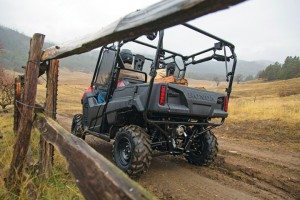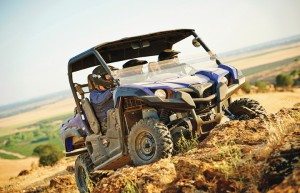Viking, Pioneer embark on Year 2 of sales
Two popular crossover UTVs preparing for their second sales seasons
Back when the UTV craze was just getting rolling, there was a time when it was all about the Yamaha Rhino. While that vehicle undoubtedly revolutionized the category and helped it go mainstream, the highly anticipated second-gen Rhino debuted in 2013 wearing a new name — Viking — that would hopefully be untainted by the legal wrangling that overshadowed the Rhino’s success at the end of its lifecycle.
Honda’s Pioneer also came to market last year with a monkey on its back, namely the lackluster reception that dogged the company’s first mainstream crossover UTV, the capable but non-thrilling Big Red.
As both of these vehicles are showing off their fancy new features and introducing their new names to customers across the country, Powersports Business checked in with six dealers selling one or both vehicles for their take on how the second generation of Honda and Yamaha crossovers are faring in the marketplace.
Honda Pioneer
Starting at $9,999, Honda’s Pioneer 700 comes with features like an automotive-style transmission with a torque converter, double-latch doors and a 1,500-pound towing capacity.
The four-seat Pioneer 700-4 starts at $11,699 and has convertible rear seating that can accommodate two, three or four riders by folding seats into the cargo bed that doesn’t require the vehicle to be as long as other four-seat UTV models.
Mike Scott, sales manager at Coeur d’Alene Powersports in Idaho, said the dealership’s off-road sales have exceeded expectations. As ATV sales have slowly declined and UTV sales have picked up the slack, he wishes Honda would increase production of both Pioneer models to match local demand for the vehicles.
“Pretty much every [Pioneer] that comes in is soon out the door and gone,” he said.
The Pioneer 700-4 has been a particularly strong performer. Scott is surprised by the strong consumer interest for the Pioneers, given the lukewarm reception of the Big Red.

“I think Honda’s doing a good job on marketing it,” Scott said. “We’ve never had a four-seat vehicle like this before, and the price stayed the same as the Big Red, so pricewise it’s the same, but there are more features and the two-seater is less.”
So far CDA Powersports has found the vehicles attracting parents and grandparents interested in taking their offspring out for a cruise on the area’s significant off-road trail system. Scott added that he’s anxious for Honda to release a sportier side-by-side in the near future.
Kyle Funge is a salesman at Mondak Motorsports in the heart of North Dakota’s oil boom that sells both the Viking and Pioneer models. (For more on Mondak Motorsports, see page 20.) So far, he’s been pleasantly surprised by sales of both, but is struggling with the slim availability of the Pioneer, which he’s been sold out of for more than two months.
His Honda customers have been interested in the reliability of the vehicle and its belt-less transmission, which appeals to farming customers in the area.
In comparison, Funge said, the Viking is approximately 10 mph faster than the Pioneer, and its three-seat design attracts the many larger guys that are in the area to work in oil production.
“The first guy I sold one to was 6-foot-7, probably weighed 350 pounds and nothing out there would do it for him,” he said “The first thing he said was, ‘I’m a bigger guy and I’m going to go hunt black bear in Canada.’ I was like, ‘This is the one you need to do.’ I saw him at a show a month ago and he said, ‘I got my bear, and the Viking worked phenomenally up there.’”
Down in West Virginia at Logan Motorcycle Sales, sales manager Shawnda Mercer said the four-seat Pioneers have also been popular due to their compact dimensions that work well on the area’s tight mountain trails.
“The seats are actually built into the bed, so that makes it even more something that a person wants in this area, because they like to hunt here, they like to go up in the mountains, and here some of those vehicles are just too wide to get on some of the trails,” she said. “The Pioneer is a really good option because it’s not too long, and it’s not too wide.”
Yamaha Viking
The Viking FI 4×4 EPS starts at $12,599 and comes with a 686cc single-cylinder four-stroke engine, standard power steering, independent suspension and a 1,500-pound towing capacity.
One sales manager, who wished to reserve his name, at a multi-line dealership in Colorado, said off-road sales in general have been very good, with the notable exception of the Yamaha Viking that has been approximately 60 percent below expected sales levels.

“We sold one right when it came out, and there was some excitement about it,” he said. “The biggest thing is when you go ride it, it’s loud and it vibrates substantially more than a twin-cylinder Polaris. That’s what consumers are choosing to go with, Polaris, even if they’re Yamaha guys.”
While he’s frustrated with the sales thus far, he’s not personally disappointed in the vehicle and feels some stronger marketing may be able to generate some more excitement in the vehicle.
“It’s only been out for about six months, so sometimes new models take a little while to catch on,” he said. “I think it has more positive than negatives for sure … the three individual seats are very nice, the ground clearance, there are a lot of nice features with it, no question. It’s a big improvement over their last UTV, the Rhino.”
Back at North Dakota’s Mondak Motorsports, Funge was dramatically more positive on his dealerships brisk Viking sales.
“I think they knocked it out of the park,” he said. “I’m very impressed with them.”
With his dealership moving most off-road units at a quick pace, Funge added that he is frustrated Yamaha still hasn’t come out with a dedicated sport side-by-side after suggesting it in the past.
In Pennsylvania, a sales manager at a multi-line dealership said off-road sales in general have been difficult. He cited the cost of vehicles and economic difficulty as the main culprits, and estimates that Viking sales have been approximately half of what the Rhino was previously doing at his facility. He added that the vehicle is too wide for the tight trails in his area, but suspects it is doing well in other parts of the country with wider trails.
So far his dealership has sold eight Vikings, primarily to homeowners looking for a combination of work and play features.
“It’s the wrong machine for this area,” he said. “They want a sport side-by-side, all the customers I talk to.”
Down in Phoenix, sales manager Nick Haider at RideNow Powersports has seen off-road consumers shifting to UTVs, as ATVs sales have gradually slowed and local track closings have impacted dirt bike sales.
His dealership’s best UTV sellers have been 1,000cc Polaris UTVs — both two- and four-seaters, sport and utility — the Ranger 900 and the Can-Am Maverick. Anything with power steering, he said, has been particularly appealing to his customers.
While not one of his top-selling UTV models, the Viking has been popular, and he is particularly excited about the just-released Special Edition Tactical Black Viking EPS model that is priced at $1,150 more than the base model.
“The consumers that want the Viking want power steering, they like the big cab, the three seats,” he said. “It’s been very popular.”
So far, the vehicle has appealed to hunters, general trail riders and riders over 40 looking to handle occasional work duties on top
of recreation.









Across the nation dealers can not seem to keep the Pioneer in stock. As spring hits we only hope Honda can keep up.